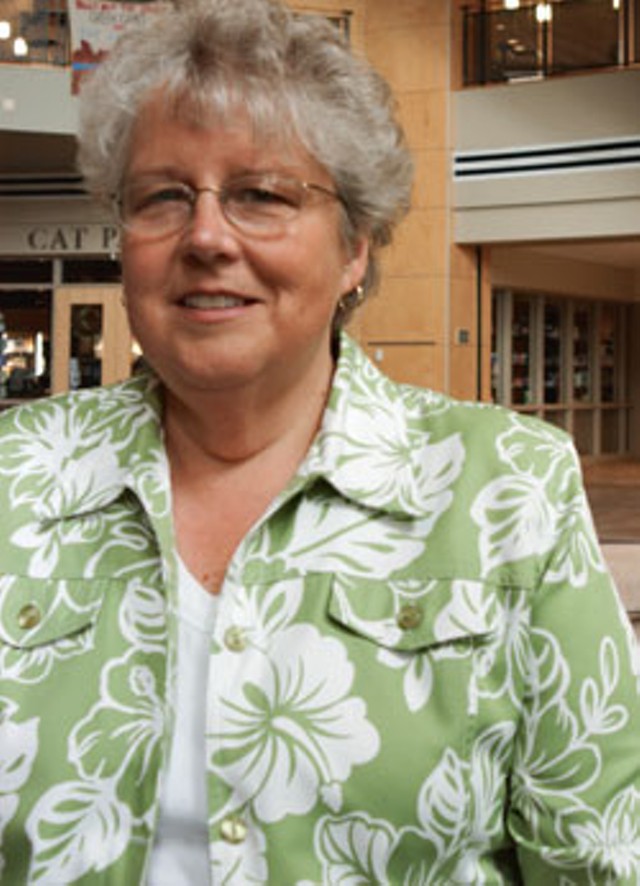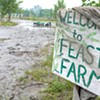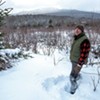Published June 15, 2011 at 10:28 a.m.
Mary Watzin watched in horror last month as muddy waves inundated homes and businesses along the shores of Lake Champlain. It “hurt in a strangely personal way,” said Watzin, who is the dean of the University of Vermont’s Rubenstein School of Environmental and Natural Resources. For more than 20 years, she’s been working on the science needed to protect and restore Lake Champlain.
“In terms of lake level, we have turned the corner, and the water level will continue to drop,” Watzin predicted. But make no mistake: “We are witnessing a historic reformation of the lake,” she said of the recent flooding, which is unlike anything seen in 200 years of regional record keeping. As a scientist, this Lake Champlain expert has a unique understanding of the deluge’s impacts on lake pollution, topography and research in Vermont.
Shorelines and fish habitats may change, but the flood will not kill the lake, Watzin assured. It will leave its mark the way the 1998 ice storm did on Vermont’s forests, she predicted.
“The shoreline will never be the same again,” Watzin told Seven Days. “It simply can’t.”
MARY WATZIN: The lake will continue to recede as long as the amount of water leaving the lake — flowing into the Richelieu River or evaporating — is greater than the amount coming in through rainfall and runoff. How quickly the lake level falls depends on how much rain falls.
It is unlikely that summer thunderstorms will produce enough water to cause the lake to rise again, but they could continue to cause lakeshore and stream bank erosion and localized flooding throughout the basin.
SD: Do you think the lake will return to normal stage — 98 feet — by next winter?
MW: It all depends on the amount of rainfall we have throughout the summer and fall. Many times, the lake falls several feet below 98 feet in the summer and early fall. I do not think that is likely this year.
SD: This year, a combination of heavy snow and rains generated flooding. If we have less snow in the future, will that mean lower lake levels?
MW: Scientists predict that we will have less snow as the climate changes, but more rain. If we simply replace the snow with rain, the lake will not be lower. The total amount of precipitation controls the lake.
SD: Are we getting a firsthand look at global climate change?
MW: Climate scientists have predicted an increase in extreme weather events with global climate change, including more heavy rains and generally wetter conditions in New England. Certainly, what we are seeing this spring is consistent with these predictions. However, it is important to remember the difference between weather and climate.
What we experience, day to day and week to week, is weather. Long-term patterns make up the climate. The weather this spring is highly unusual, far outside the norm even with climate-change predictions in mind; however, there have always been unusual weather years.
I do believe we have entered a wetter and stormier climate pattern — the last two decades of rainfall and runoff data bear this out — but this year’s unusual combination of heavy snow and record-breaking rain does not represent “the new normal,” as some people have said.
SD: Tell us about flood-related pollution in the lake. Has your office conducted any studies to gauge the short- and long-term impacts?
MW: The pollutant loading to the lake is probably a thousand times that in a normal year. We can see the sediment and trash in the water, but along with what is visible has come tons of phosphorus, nitrogen, organic matter and a huge variety of chemicals never intended for the lake.
In addition to stream and riverbank erosion and wash-off from the land, there have been many sewer-system overflows, flooded septic fields and agricultural lands, and overtaxed systems of many sorts. The Lake Champlain Basin Program reported that in just one day in late April, the Winooski River phosphorus load was 77 metric tons, which is equal to half the usual annual load for this river.
We have begun sampling for water quality and the biotic impacts of the flood, and we will continue this sampling throughout the summer and into the fall. It is very hard to predict what all this pollution will mean for Lake Champlain.
Right now, much of the phosphorus and other contamination is bound to the suspended particles in the water, and thus it is available to algae or other organisms. Later in the summer and in the fall, after bacteria begin to break down particles that have settled to the bottom of the lake, some of the phosphorus and other nutrients may be released into the overlying water. This might be when greater impacts occur, including algae blooms.
I have spent more than a decade studying potentially toxic algae blooms in Lake Champlain. It is a complex story, and many factors contribute to algae blooms. This year, with all its extremes, will provide a wealth of useful information for understanding what drives these noxious blooms. Once we understand what controls the blooms, we can more effectively predict outbreaks and target management actions to control them.
SD: What is the toxicity of the water right now?
MW: We don’t yet have all the results of all of our chemical analyses. Although there is probably a variety of pollutants in the water, they may not be at toxic levels because the large volume of water has diluted them. We have started our regular scanning for potentially toxic blue-green algae, and these nuisance species are not yet present in any significant numbers.
SD: Did lakefront development play a role in all of this?
MW: We have never faced lake levels like this before, so people were comfortable building close to the lake without worrying about water rising above 101 feet or so. If current climate-change predictions hold true, we should expect higher lake levels in the coming years — not necessarily the historic levels we saw this year — again, this was a highly unusual spring — but higher nevertheless.
That suggests we should not simply rebuild in all the places where we had buildings and other structures before, but move inland a bit. An undeveloped shoreline has adaptive capacity — the cobbles, sand, mud and plants can absorb the wave energy, and move with the wind, waves and currents during storms. When human structures interfere with that movement, it usually only makes the problem larger, damaging the structures themselves as well as the natural habitats along the shoreline. We need to think about the likely scenarios coming with climate change and adapt to them as proactively as we can.
SD: Drifting objects — from refrigerators to bed frames — have been found in and along the lake. What advice do you give to boaters and anglers as they hit the water this season?
MW: Be careful while motoring on the lake, but there is no need to stay away. What you see at the surface is only a fraction of what has been washed into the lake. The lake bottom has undoubtedly changed, and there are submerged hazards in many shallow water areas. That said, I hope anglers and boaters will still enjoy as much of the summer season as possible. It may be a whole new adventure to find the fish, but they are there.
SD: Please elaborate on the changes to the lake bottom.
MW: Tons and tons of sediment have been carried to the lake and settled to the bottom. The lake bottom has changed, and boaters should be careful and use a depth sounder if they have one.
These changes also have huge implications for the biota of Lake Champlain. The bottom waters are habitat for many species. Some of these, like mussels, have been buried, while others are now swimming and foraging in different areas. The temperature swings and water-level changes have affected fish spawning and emergence of fry. Visual cues for fish have been erased. And as many have probably noticed, we have carp, pike and bass spawning in backyard lawns and farmers’ fields.
There will be winners and losers from these changes, and it will likely take a while to sort out which species are in which category. For example, some invasive plants like water chestnut, water milfoil and purple loosestrife may invade new areas, but zebra mussels and native mussels may be buried in some of their previous best habitats. For many other species, we are just beginning to sort out the complexity of the changes — and their implications.
SD: Has any aspect of the flooding posed long-term effects to the rivers that feed Lake Champlain?
MW: The rivers that feed Lake Champlain have changed dramatically, too. A huge amount of soil and sediment has moved around. Riverbanks have been cut back significantly in some locations, and large deposits have been laid down in other areas, including wetlands in floodplains and river mouths.
River and stream channels and banks are formed and shaped by the water that flows through them. There has been a dramatic reshaping in many areas, and these channels will continue to adjust until they reach a new stable point — probably several years into the future.
SD: Does this flood have any benefits?
MW: This event will be a boon for scientific research and understanding how Lake Champlain functions. Just as a cardiologist learns much about heart health from a stress test, environmental scientists will learn much about lake health from this dramatic stressor.
If good can come from bad, this will be the good: new understanding about how the lake absorbs pollution and responds to a huge reshaping of its habitats. The information we glean will inform our phosphorus-management strategy and virtually every other facet of natural resource management for years to come.
From an ecological perspective, most of the attention has focused on the negative impacts of the flood. However, there are some positive effects for the surrounding river mouths and wetlands; they have been rejuvenated with sediment and nutrients, seeds have been dispersed broadly, and germination of new plants is occurring in many areas.
SD: What is the light at the end of the tunnel for homeowners and businesses that rely on the lake during the summer?
MW: Water clarity will improve as less soil and other material is washed down the lake and what is there settles to the bottom or flows out of the lake at the Richelieu River.
As the pollutant loading declines and water temperature warms, it should be safe to swim in most regular swimming areas. In fact, recent sampling by the state of Vermont suggests that pathogen levels are already low, but everyone would be well advised to pay attention to public-health warnings throughout the summer when choosing where to dive.
More By This Author
About the Artist

Matthew Thorsen
Bio:
Matthew Thorsen was a photographer for Seven Days 1995-2018. Read all about his life and work here.
Matthew Thorsen was a photographer for Seven Days 1995-2018. Read all about his life and work here.
Speaking of...
-

Richmond Vows to Return to 'Full Fluoride' Levels
Oct 3, 2022 -

Richmond Learns a Town Official Lowered the Fluoride Level in Its Water for Years
Sep 28, 2022 -

Burlington Food Businesses Take a Hit with Weekend Water Issues
Feb 17, 2020 -

Lawmakers Question State's Approach to Parking Lot Runoff
Jan 17, 2018 -

A Rutland Nonprofit Purifies Water in Haiti and Honduras
Nov 23, 2016 - More »
Comments
Comments are closed.
From 2014-2020, Seven Days allowed readers to comment on all stories posted on our website. While we've appreciated the suggestions and insights, right now Seven Days is prioritizing our core mission — producing high-quality, responsible local journalism — over moderating online debates between readers.
To criticize, correct or praise our reporting, please send us a letter to the editor or send us a tip. We’ll check it out and report the results.
Online comments may return when we have better tech tools for managing them. Thanks for reading.















































